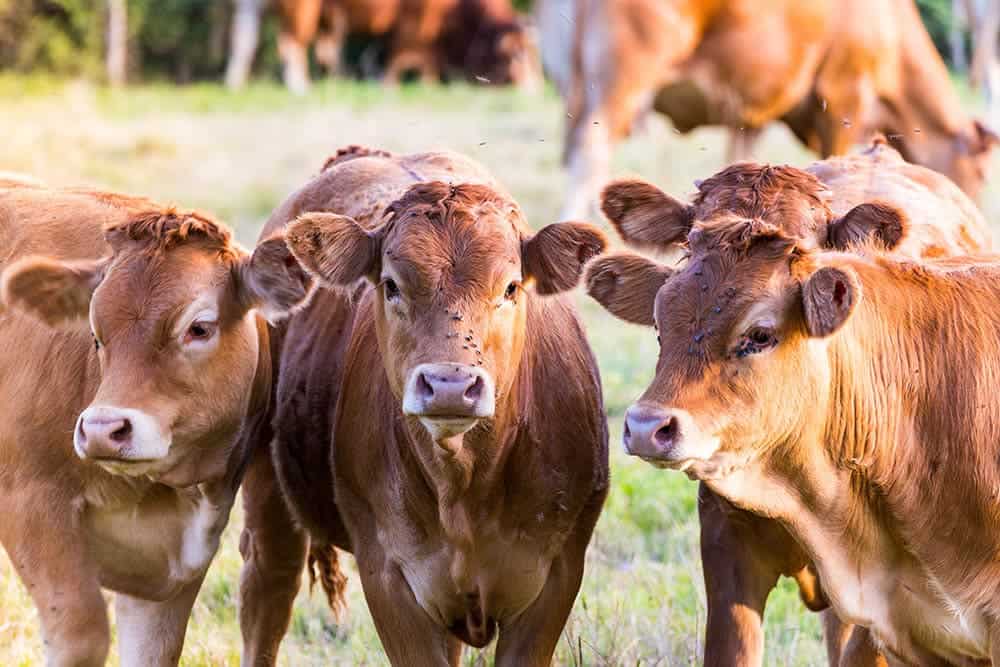Parthenais cattle are a highly sought beef breed from Parthenay, a town that was part of an important cattle market in France during the Middle Ages. The breed is hardy, large, and heavy, once being a triple purpose cow used for milk, beef, and draught work.
Currently, Parthenais cattle are primarily used for beef production and offer high-quality meat and fast-growing, hardy calves. The ancestral background of the rich milk and strong maternal instinct of the cows offer easy calving and impressive calves.

Quick Facts About Parthenais Cattle
| Breed Name: | Parthenais |
| Place of Origin: | Parthenay, France |
| Uses: | Beef, milk, draught work |
| Bull (Male) Size: | 2,600 lbs |
| Cow (Female) Size: | 1,600 lbs |
| Color: | Golden brown |
| Lifespan: | 15–20 years |
| Climate Tolerance: | Varies |
| Care Level: | Mild |
| Production: | High |
Parthenais Cattle Origins
Parthenais cattle originated in Parthenay, France, around the borders of Brittany and the Charente Basin. They’re one of the oldest French cattle breeds and date back to ancient times. The Herdbook for Parthenais cattle was established in 1893.
Historically, these cattle were used for high-fat milk, draught work, and meat, though they’re now primarily used for meat. As agriculture was mechanized, fewer draught cattle were needed, and the breed shifted to produce high-quality meat instead of lean, heavy muscle for work. The breed then declined, focusing on beef production only.
Parthenais Cattle Characteristics
Parthenais cattle may be a golden tan to reddish buckskin to dark brown color with dark brown or black points around the neck, eyes, ears, and jaw. The face and muzzle tend to be lighter, while the nose, hooves, and tail are black.
Purebred Parthenais cattle are well-framed, double-muscled, and strong. They’re highly productive and fertile producers of high-quality, lean meat. The fertility and ease of calving make them a productive breed, as well as the hardiness of the calves. As a former dairy breed, the Parthenais cows offer high milk yields to produce fast-growing calves. Most full-blooded calves require no assistance.
Uses
Parthenais cattle were once used for milk production and draught work. Once farming was mechanized, the need for draught cattle declined and the breed was switched to beef production. Now, Parthenais cattle are raised primarily for beef and yield a high killing percentage and meat-to-bone ratio with rich meat that’s low in cholesterol.

Appearance & Varieties
Parthenais cattle come in a light golden to dark wheaten color with dark brown or black markings and black hooves, nose, and ear edges. Both sexes are horned, and the horns have a lyre shape. Parthenais cattle may be crossbred with other cattle breeds to produce desirable traits, but there’s high demand for pedigreed animals.
Population/Distribution/Habitat
The Parthenais originated in France and are now produced in the UK, Ireland, the US, and Canada. It’s tolerant of many different climate conditions, including extreme temperatures, and can forage on diverse terrain. The cattle have excellent disease resistance as well.
Are Parthenais Cattle Good for Small-Scale Farming?
The demand for pedigreed Parthenais cattle outweighs supply, so these cattle can be lucrative for farmers. They’re docile and easy to keep and breed, making them suitable for both small-scale and large-scale farming. They can tolerate most climates and rough terrain and show impressive disease resistance. Parthenais cattle are low-maintenance and fast to mature.
Parthenais cattle are an ancient French cattle breed with a history of hard work, high production, and strong maternal instincts. They’re hardy, docile cattle that take well to different climates and environments for small- and large-scale beef production.
Featured Image Credit: Pitamaha, Shutterstock
